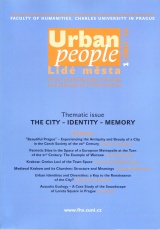“Beautiful Prague”
Experiencing the Antiquity and Beauty of a City in the Czech Society of the 20th Century
DOI:
https://doi.org/10.14712/12128112.3787Klíčová slova:
urban anthropology, city, monument, memory, national movement, socialismAbstrakt
This study analyzes the relation of the capital of the Czech lands to monuments, which are characterized as the tangibility of memories. The institutionalization of monument preservation founded on a scientific basis was simultaneous with the inception of modern Czech society. Until that time, sites of historical interest participated in the construction of national history. From the turn of the 20th century guardians of memory attempted to take into account the artistic-historical value of monuments. During the First Republic, preservationists tried to cultivate the relation of society to the tangible heritage of the past. That was the time of the “discovery” of natural monuments, while, on the other hand, there were endangered monuments which, in the Czech consciousness, symbolized the supposedly hostile Austro-Hungarian monarchy. Monuments that became symbols of Czechoslovakness drew greater interest. The First Republic brought the first great conflict between preservationists and so-called modern architects. After the Second World War, the relationship to memorials in Prague, which was practically undamaged, was protected by conservationists loyal to the new regime. While, in the first postwar years, they presented the memorials as a source of national self-confidence and as a magnet for tourism, after the February Revolution (1946) they operated with the concept of the socialist city as a city with a generational memory. Criticism of the regime appeared first in a veiled form in the mid-1970s (volunteers in Olsansky Cemetery trimmed the graves of representatives of the Czech National Uprising in an atmosphere of depreciation of Czech national identity). From 1988 this was already openly articulated. The target of criticism became the arrogance of the powerful elite leading to unnecessary demolition and inappropriate interference in Prague architecture. Despite virtually no financial resources, the Club for Ancient Prague managed, in the postwar era, to save a great number of valuable memorials in the center and on the oustskirts of Prague.
Stahování
Publikováno
Jak citovat
Číslo
Sekce
Licence

Tato práce je licencována pod Mezinárodní licencí Creative Commons Attribution-NonCommercial-NoDerivatives 4.0.


